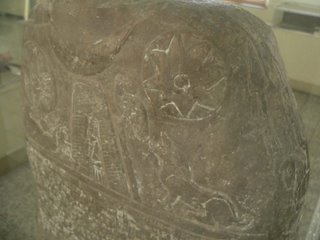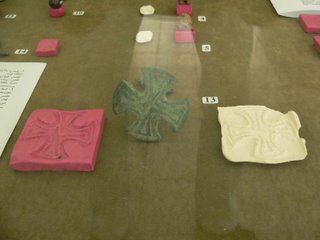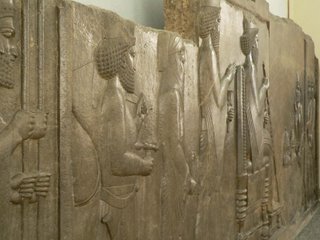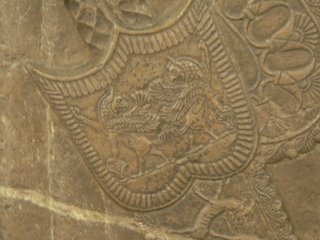Continuation: Iranian National Museum Pre Islamic Era II
Well people, I have a problem and that is I took too many picture in Yazd (well to many as far as my camera and memory stick are concerned) so you are gonna get more pictures of the National Museum and Tehran's Numerous palace complex's until I can figure something out.

This piece is from the Ilami Era, a dynasty that ruled in the area approximately from Tigris (west) to Zagros Mountains in the east and Persian Gulf to South and Kurdistan to the north. Ilamis were the last pre Indo European rulers in Iran they were dislocated from power by the alliance of the Medes (central Zagross) and the Persians (Southern Zagross and Fars) which propelled the Medes into power. The piece shows the sun and a lion and some writings.
The sun and the lion are very important figures in stories and symbolisms of the area and all the civilization that dwelled here and in Iran they continued to be important well into 20 century.
The Embelem of the Iranian monarchies from Safavid until the Islamic Revolution used to be a lion holding a sword while the sun is dawning from behind the body of the lion. In some official documents, and carvings there are two lion of the same posture facing each other while a Two horned Crown (the story of which I with hold until the post on Iranian National Jewelry Museum) is in between.

The Cross stamps, these stamps are from the Period of the Medes who with alliance with the Persians ruled over the area that constitutes Western Iran short of today's Azerbaijan and eastern Iraq short of Kurdish Iraq and Syria (this area was the kingdom of Ashur or as the Greek say the Assyrians, who were destroyed by the Persian later on in time of Cyrus the second or Cyrus the Great) the cross has been a important symbol all around Mesopotamia and Iranian Plateau. The last king of the Medes was the Grandfather of Cyrus.

This is the picture of the royal court of the Achaemenians (The Persians) in Pasargad (Persian name of it) itor Perspolis (Greek name of it, meaning Place of the Persians). The king is seated on the throne, and behind him are the crown prince, the High Priest, royal arms holder carrying the short sword, the axe and the bow and two members of the royal guards (Known as Eternal Guards). In front, is the royal Treasurer who was also the person in possession of the royal stamps (bad idea if you ask me, you don't give both the coin and the stamp of approval to the same guy he could get a bill from his brother in law ot items not delivered and just pay him who his gonna ) followed by two royal guards.
It is not sure who is king if the king is Darius then the person behind him is Xerxes (Khashayarsha) who in continuation of his father campaign in Greece, defeated the Spartans in the battle of Thermopolis and occupied and burned Athens and on the way back by the see was routed by the Athenian navy, who had taken to the sea in face of the approaching Persian Army, in battle of Salamis, in an early demonstration of importance of having a strong navy. In any case, if the king is Xerxes (Khashayarsha) then the crown prince is Ardeshir deraz-dast(Artaxerxes I) (Ardeshir the far reacher, meaning that he could reach the farthest) who in time of the Peloponnesian wars was funding the Spartan side of the war, according to Thucydidus.

This person is the royal arms holder, the sword is the short sword and it is know as the persian sword, below are the engravings on the handle of the sword, please keep in mind that these are all made in stone and there can be no room for error.


This piece is from the Ilami Era, a dynasty that ruled in the area approximately from Tigris (west) to Zagros Mountains in the east and Persian Gulf to South and Kurdistan to the north. Ilamis were the last pre Indo European rulers in Iran they were dislocated from power by the alliance of the Medes (central Zagross) and the Persians (Southern Zagross and Fars) which propelled the Medes into power. The piece shows the sun and a lion and some writings.
The sun and the lion are very important figures in stories and symbolisms of the area and all the civilization that dwelled here and in Iran they continued to be important well into 20 century.
The Embelem of the Iranian monarchies from Safavid until the Islamic Revolution used to be a lion holding a sword while the sun is dawning from behind the body of the lion. In some official documents, and carvings there are two lion of the same posture facing each other while a Two horned Crown (the story of which I with hold until the post on Iranian National Jewelry Museum) is in between.

The Cross stamps, these stamps are from the Period of the Medes who with alliance with the Persians ruled over the area that constitutes Western Iran short of today's Azerbaijan and eastern Iraq short of Kurdish Iraq and Syria (this area was the kingdom of Ashur or as the Greek say the Assyrians, who were destroyed by the Persian later on in time of Cyrus the second or Cyrus the Great) the cross has been a important symbol all around Mesopotamia and Iranian Plateau. The last king of the Medes was the Grandfather of Cyrus.

This is the picture of the royal court of the Achaemenians (The Persians) in Pasargad (Persian name of it) itor Perspolis (Greek name of it, meaning Place of the Persians). The king is seated on the throne, and behind him are the crown prince, the High Priest, royal arms holder carrying the short sword, the axe and the bow and two members of the royal guards (Known as Eternal Guards). In front, is the royal Treasurer who was also the person in possession of the royal stamps (bad idea if you ask me, you don't give both the coin and the stamp of approval to the same guy he could get a bill from his brother in law ot items not delivered and just pay him who his gonna ) followed by two royal guards.
It is not sure who is king if the king is Darius then the person behind him is Xerxes (Khashayarsha) who in continuation of his father campaign in Greece, defeated the Spartans in the battle of Thermopolis and occupied and burned Athens and on the way back by the see was routed by the Athenian navy, who had taken to the sea in face of the approaching Persian Army, in battle of Salamis, in an early demonstration of importance of having a strong navy. In any case, if the king is Xerxes (Khashayarsha) then the crown prince is Ardeshir deraz-dast(Artaxerxes I) (Ardeshir the far reacher, meaning that he could reach the farthest) who in time of the Peloponnesian wars was funding the Spartan side of the war, according to Thucydidus.

This person is the royal arms holder, the sword is the short sword and it is know as the persian sword, below are the engravings on the handle of the sword, please keep in mind that these are all made in stone and there can be no room for error.


0 Comments:
Post a Comment
<< Home